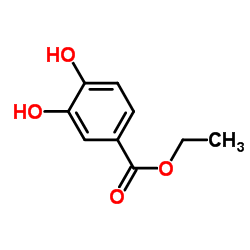The prolyl 4-hydroxylase inhibitor ethyl-3,4-dihydroxybenzoate generates effective iron deficiency in cultured cells.
Jian Wang, Joan L Buss, Guohua Chen, Prem Ponka, Kostas Pantopoulos
Index: FEBS Lett. 529(2-3) , 309-12, (2002)
Full Text: HTML
Abstract
Ethyl-3,4-dihydroxybenzoate (EDHB) is commonly utilized as a substrate analog and competitive inhibitor of prolyl 4-hydroxylases. These iron-dependent enzymes have received a lot of attention for their involvement in crucial biochemical pathways such as collagen maturation and oxygen sensing. Since EDHB is also capable of chelating the enzyme-bound iron, we study here its function as a chelator. We show that the affinity of EDHB for ferric iron is significantly lower than that of desferrioxamine. Nevertheless, EDHB is sufficient to promote effective iron deficiency in cells, reflected in the activation of the iron-responsive element/iron regulatory protein regulatory network. Thus, treatment of B6 fibroblasts with EDHB results in slow activation of iron regulatory protein 1 accompanied by an increase in transferrin receptor levels and reduction of the ferritin pool.
Related Compounds
| Structure | Name/CAS No. | Molecular Formula | Articles |
|---|---|---|---|
 |
Ethyl 3,4-dihydroxybenzoate
CAS:3943-89-3 |
C9H10O4 |
|
Antioxidant activity of protocatechuates evaluated by DPPH, ...
2016-03-01 [Food Chem. 194 , 749-57, (2015)] |
|
Inhibitory Effect of Dried Pomegranate Concentration Powder ...
2015-01-01 [Int. J. Mol. Sci. 16 , 24219-42, (2015)] |
|
Evidence for a role of collagen synthesis in arterial smooth...
1998-05-01 [J. Clin. Invest. 101(9) , 1889-98, (1998)] |
|
Improvement of pro-oxidant capacity of protocatechuic acid b...
2014-01-01 [PLoS ONE 9(10) , e110277, (2014)] |
|
Analytical method for the determination and a survey of para...
2015-10-01 [Environ. Res. 142 , 452-60, (2015)] |